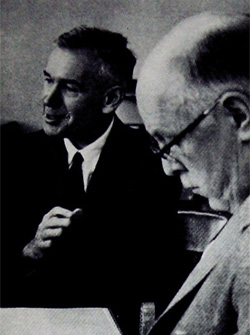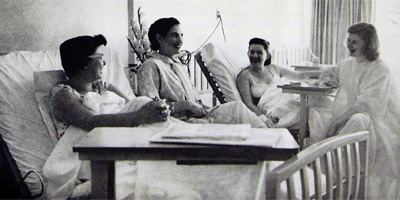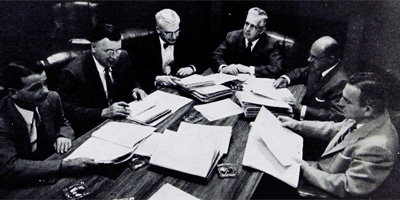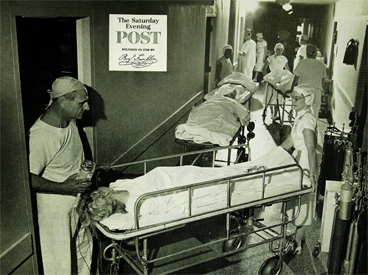At least partly responsible for this precarious position, and for many of the troubles that have long beset the modern health-insurance program, is the astonishing fact that there has never been complete understanding of the purposes of health insurance. Even today, there is no agreement on whether it is—or should be—primarily an anti-state-medicine plan, an insurance plan to cushion the blow of big medical bills, or a budgeting system to prepay nearly all medical costs.
Although health insurance is generally considered almost as new as penicillin its record on this continent alone goes back more than three centuries. In the year 1655, according to one historian, the first health-service prepayment plan in North America was set up in a tiny village on the island of Montreal. There one Étienne Bouchard, master surgeon, contracted to provide care to some three dozen families in case of illness, at 100 sous each per year. Even in that first contract, however, there were exceptions; Maitre Bouchard declined to render such services for “smallpox, leprosy, epilepsy, or cutting for kidney stone.”
In the United States another plan was established in 1798, when the Collector of Customs was required by Congress to collect the sum of 20 cents a month from the wages of every American sailor. The funds were to be used by the President “to provide for the temporary relief and maintenance of sick or disabled seamen.”
Thereafter, for more than a century, a variety of agencies entered the field. Most of these pioneering attempts failed and nearly all the companies went into bankruptcy. In 1929, the latest chapter in health insurance began when Dr. Justin Ford Kimball became executive vice president of Baylor University, in charge of the university’s Dallas medical units. He found two problems desperately awaiting solution.
“The citizens of Dallas were in financial straits,” he said later. “They were unable to face the costs of paying hospital bills. At the same time, Baylor was in desperate need of money. Its hospital was badly overdrawn. It owed more than $1.5 million.”
Neither a physician nor a hospital expert, but a professional educator, Doctor Kimball turned to an ingenious program he had started among Dallas schoolteachers several years before. Finding that these underpaid workers were frequently unable to meet the costs of illness, he had established what he termed a “sick-benefit fund,” with each teacher contributing one dollar a month into a
common pool and drawing from that fund if he became ill.
Late in December 1929, he proposed a similar plan to help patients and at the same time rescue the Baylor hospital from financial catastrophe. Under this new arrangement, each subscriber would pay 50 cents a month to Baylor; in turn, the university would provide the subscriber with necessary hospitalization up to a maximum of 21 days.
Hundreds of schoolteachers signed up under the program, quickly followed by employees of the Dallas News, the Republic National Bank, and the Dallas Times Herald. A few days after the contracts were signed, a teacher named Alma Dixon slipped on the ice and fractured a heel bone.
“You’ll have to go to the hospital for a few days,” her doctor told her.
“Oh, no!” she protested. “I can’t afford it!”
“But you’re a teacher,” the physician said. “Aren’t you in on that new plan of Doctor Kimball’s?”
Mrs. Dixon wasn’t altogether sure. “Well, he asked us to join some kind of organization,” she said. “We’re paying fifty cents a month. But I don’t exactly know what it means.”
“It means that you’ve got hospital insurance,” the doctor explained.
Mrs. Dixon thus became the first patient of what was destined to become the Blue Cross plan. At the outset, the program developed slowly, with most hospitals viewing the idea with suspicion and refusing to co-operate. In 1932, the city of Sacramento, California, made history by setting up a city-wide plan with all city hospitals participating. Soon after, a similar co-operative program was organized by 17 hospitals in Essex County, New Jersey.
“We had to do something,” a hospital official said. “The depression was with us. Those 17 hospitals together had uncollectible accounts of about a quarter of a million dollars.”

In St. Paul, Minnesota, another co-operative plan was started by E. A. van Steenwyk, the man who is credited with coining the name of Blue Cross and also with finding a new way to get subscribers.
“In those days,” he said, “we didn’t have an opportunity to advertise, because we had no money. But radio offered all kinds of help.”
Routinely, he would go to the local radio station, present his story about prepayment and give his telephone number, and then dash back to his office to answer the telephone calls that flooded in.
In the next five or six years, Blue Cross began to spread across the nation. “With a courage based largely on ignorance,” one modern observer wrote, “the Blue Cross people stepped in and did a job that had to be done.”
Even at that early period, there were signs of trouble. In various areas, Blue Cross plans came close to financial disaster. Strong labor unions had been courted in the drive to sell group policies, and several union leaders demonstrated a growing tendency to dictate Blue Cross operations. Even more significant were increasing indications of abuse.

“I note more and more patients who could be given excellent care at home, but who seek hospitalization because their hospital care is insured,” one physician wrote to a colleague early in 1938. “Do you believe such a trend might eventually increase the costs of hospital care and of hospital insurance?”
Most hospital men apparently dismissed any such possibility. To them, the primary goal was keeping their hospital occupied by patients who, alone or with their Blue Cross policy, could pay for their care. “The expensive hospital bed,” it was customarily stated, “is the empty hospital bed.”
In spite of these early danger signals, Blue Cross continued to spread. By 1939, it had become a nationwide program. Nearly 3,000,000 subscribers were enrolled, and a few people—usually ignored as wild men—were predicting that the plan might soon cover as many a 10,000,000. Practically no one foresaw today’s enrollment of more than 50,000, 000 in Blue Cross alone.
In 1939, another major development occurred in health insurance. This was the creation of California Physicians’ Service, the first state-wide program to provide prepayment of doctor bills. It was developed by the doctors themselves, the members of the California Medical Association, after five years of remarkable debate, dissension, and incredible reversals of course.
At one point, leaders of the California medical group had gone to the state legislature and actually asked for a compulsory health insurance or state medical plan. Their request was rejected. Soon afterward, the California doctors did a complete about-face and violently denounced a compulsory-health-insurance plan advocated by the governor of the state.
Similar confusion was apparent in other medical organizations. For a while, the American Medical Association opposed not only compulsory health insurance, which it still opposes, but also at least some types of voluntary health insurance. In an editorial published in the Journal of the AMA—an editorial which some AMA leaders would prefer to forget—it was claimed that health-insurance contracts made with organized groups of doctors were contrary to sound public policy.
“The shortest road to the commercialization of the practice of medicine,” said the Journal, “is through the supposedly rosy path of insurance.”
Regardless of these dire prophecies, the new California Physicians’ Service generated no noisy revolution. Its basic pattern was soon copied by the Michigan State Medical Society and spread particularly through the Detroit automobile industry. By 1941, eight of these plans—now known as Blue Shield—had enrolled 500,000 members, and the idea of prepayment of doctor bills was growing steadily.

Meanwhile, the nation’s huge insurance industry began to move. Some companies had actually been in the health insurance business long before the rise of Blue Cross or Blue Shield. Stimulated at least in part by the success of these two, known together as “the Blues,” one company after another began offering a wide variety of health-insurance policies to groups and to individuals. They constantly kept ahead of Blue Shield in the number of people covered with medical or surgical insurance. By 1950, they had even surpassed Blue Cross in the number covered with hospital insurance.
Become a Saturday Evening Post member and enjoy unlimited access. Subscribe now




Comments
People unable to leave the hospital for example when they are on IV antibiotics are a common source of over-hospitalization. THey are not released and they are kept against their will in the hospital. And then the insurance company will not pay the stay. They are seen by a battery of doctors they did not solicit sent by the hospital and find themselves with 30,000 to 70,000 of medical debt. I have also seen this when there is a surgical complication for a routine surgery and this is not allowed or noted and the patient is required to stay at the hospital and is not released to go home because of excessive wound care or risk of infection.
It has crossed my mind many times, that Doctors, hospitals and any qualified health providers have the commercial advantage of limited accounts receivables by the portion of their services paid by Uncle Sam through the insurance industry. If I’m wrong, please explain.
Enjoying the articlea(s)